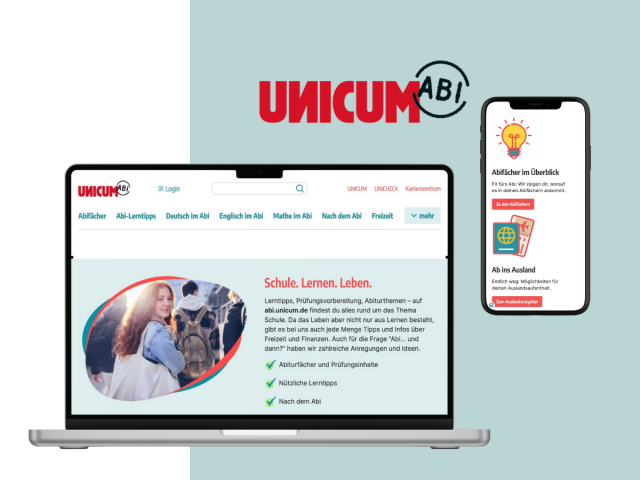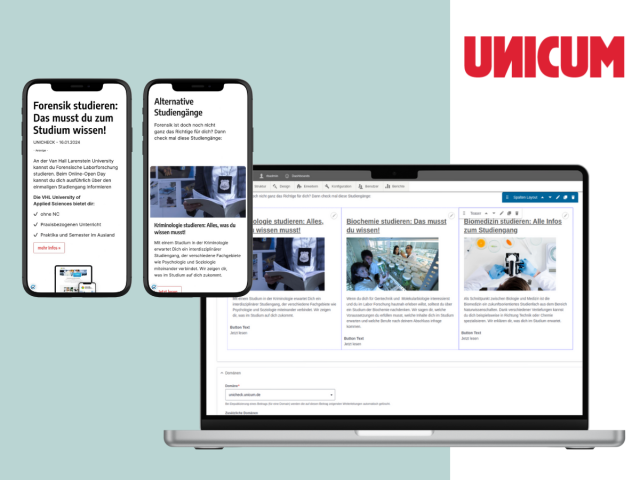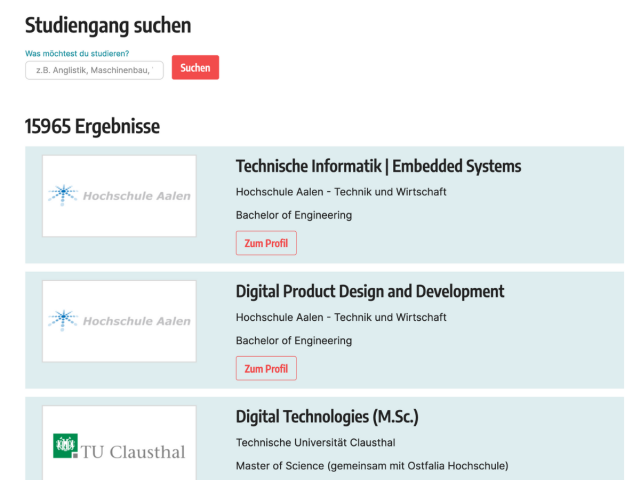Unicum offers the leading information portals for young students: unicum.de, unicheck.de, karriere.unicum.de and abi.unicum.de. Here young adults can find useful information on studying, starting a career, careers and campus life. It also offers services such as job exchanges, learning aids and exam preparation.
At the start of the project, it became clear that the editorial team in particular needed technical support in order to work better and more efficiently. Due to the constant expansion of the system, the backend had become confusing. It took many manual steps to make the desired results visible in the front end.
The top difficulties for the editorial team were the long loading times in media management and ad positioning that only worked by trial and error. In addition, the content interface to the career center was incomplete, which resulted in additional work. The editorial team and project management would like to see simplified management of the various platforms.
The portals were also visually outdated. The focus was particularly on optimizations for mobile use by users, both in terms of usability and performance.
The aim of the relaunch was to create a better user experience for the young target group and for the Unicum editors. Externally, a visual rebrush and a new category concept were created, while performance took a quantum leap thanks to a decoupled architecture. Multidomain publishing saved editors an enormous amount of time and a specially adapted backend offers improved convenience when editing content.
Project Overview
In order to support the editorial workflows as well as possible, we developed our own backend theme with which disruptive elements can be hidden, the interface is tidy and clear.
We developed a “pseudo-preview” for content elements to give an idea of how the editorial content will be displayed later on. This preview is a compromise between real presentation in the front end and cost efficiency in implementation.
In the old system, a lot of content was stored in a WYSIWYG editor. In order to create better control and reusability of content, all new content is now created in components. The content can be rearranged using drag & drop.
The decoupled architecture with a fast SvelteKit frontend paired with the good caching options of the Drupal system probably had the greatest impact on performance. REST was used as the interface between the systems and a separate serializer was created to prepare the content. Modern image formats and asynchronous operations were further components of the performance optimization. The use of modern ad server technology also improved page load times.
To give the editorial team even more control over advertising placements, advertising spaces have a representation as a Drupal backend component. This can again be placed via drag & drop. In addition, advertising can be partially or completely switched off on some pages.
Measuring user-defined successes was very important to the editorial team. Consent and analytics are therefore built directly into the frontend to make almost every conceivable requirement possible.
All portals will continue to be loaded from one Drupal instance. This allows the editorial team to publish articles on several portals or reuse media. Internal links between the portals are easily possible. A service takes care of SEO requirements such as a cannonical URL.
Outcomes in a Nutshell
- Increased performance through caching and decoupled architecture
- Backend theme with preview option for editors
- Content can be placed across domains
- Better integration and global control options for advertising spaces
- Fine-grained tracking options
- Hybrid operation with legacy Drupal 7 (job board) and Drupal 10 (content area)
Challenges
Hybrid operation with legacy Drupal 7 and Drupal 10 enables
The integration with the Unicum career portal was achieved by delivering all editorial pages of the career portal via a Svelte frontend using URL evaluation in the web server. Other functionalities of the portal continue to be served from the Drupal 7 instance. This enables hybrid operation with the legacy Drupal 7 job board and Drupal 10 for all other content areas.
Incremental migration
The migration was carried out in several steps because a direct data transfer from unstructured data would have been very laborious. Therefore, we first transferred or reassigned all structured data and users. The actual article content was stored as a copy & paste template in the new articles, but then editorially converted into components. This also had the effect of editorial training and the content was streamlined and checked for up-to-dateness.
Conclusion
Imagine the entire Unicum online editorial team sitting in a wellness spa, wrapped up in fluffy bathrobes, treating themselves to a luxurious full-body massage: tense muscles are kneaded, knots are loosened and the skin is pampered with fragrant oils. After the treatment, they float out of the spa feeling refreshed and light and hardly remember how tired and tense they felt beforehand.
To create this carefree feeling of happiness for our client, we used the full range of possibilities offered by Drupal, our favorite CMS. It is a showcase project for media companies and online editorial teams. It proves how the meticulous assembly of many individual pieces of the puzzle can make a team's daily work enormously more fun and efficient.
- Fun through clarity.
- Fun through individual treatment.
- Fun through simplification.
- Fun through speed.
- Fun through control ;-)
And the best for last. Fun promotes identification with the company, leads to greater employee loyalty and saves the tiresome search for new staff. Win-win-win for everyone involved!




